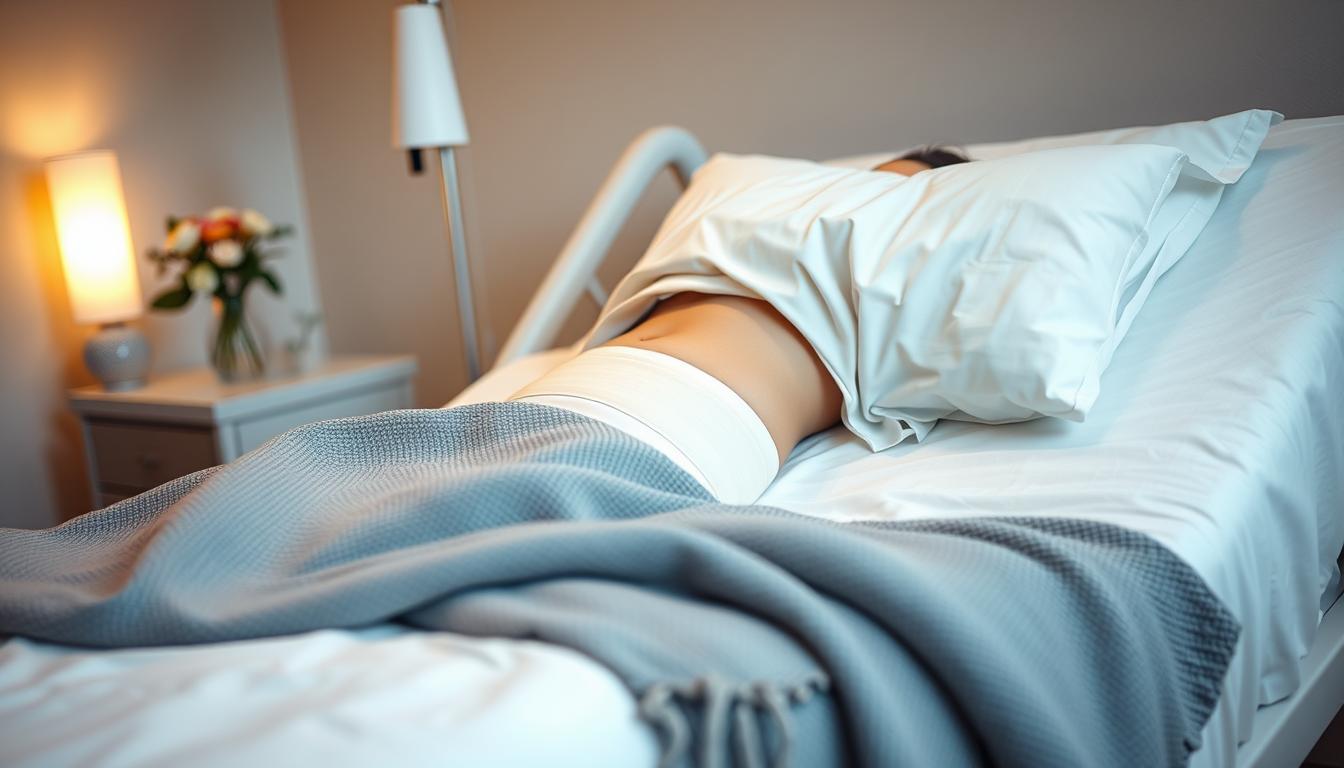Undergoing a tummy tuck surgery is a significant decision, and understanding what to expect during the recovery process is crucial for achieving optimal results.
Every individual’s healing journey is unique, influenced by factors such as age, overall health, and body weight. Giving your body enough time to heal effectively is vital.
Typically, patients are required to stay in the hospital for several hours to a day after the surgery before beginning their at-home recovery.
Key Takeaways
- Understand the factors that influence your recovery process.
- Prepare for a hospital stay after the surgery.
- Allow your body sufficient time to heal.
- Follow a comprehensive guide for each stage of recovery.
- Proper preparation and post-surgery care are crucial for a smooth recovery.
Understanding Tummy Tuck Surgery and Recovery Expectations
Understanding the intricacies of tummy tuck surgery is crucial for setting realistic recovery expectations. A tummy tuck, or abdominoplasty, is a surgical procedure aimed at flattening the abdomen by removing excess fat and skin, and tightening the abdominal muscles. The recovery process is just as important as the surgery itself, and being informed can significantly impact the healing journey.
What Is a Tummy Tuck Procedure?
The tummy tuck procedure involves making an incision in the lower abdomen, through which the surgeon removes excess skin and fat, and tightens the abdominal muscles. This surgery can be performed in various forms, including mini, full, or extended abdominoplasty, each with its own specific techniques and recovery timelines.
Factors That Affect Your Recovery Timeline
Several factors influence the recovery timeline after a tummy tuck. These include the patient’s age, overall health status, body weight, smoking status, and the extent of the procedure.
| Factor | Impact on Recovery |
|---|---|
| Age | Younger patients tend to recover faster due to better skin elasticity and cellular regeneration. |
| Health Status | Conditions like diabetes or autoimmune disorders can prolong healing time. |
| Body Weight | Patients at a healthy weight typically experience fewer complications and faster recovery. |
| Smoking Status | Smoking can significantly impede the recovery process by restricting blood flow and oxygen necessary for tissue repair. |
| Extent of Procedure | Mini tummy tucks generally require less recovery time than full or extended abdominoplasties. |
Preparing for Your Tummy Tuck Recovery
Before undergoing a tummy tuck, it’s essential to prepare your home and support system for a smooth recovery after surgery. A well-prepared environment can significantly reduce stress and discomfort during the healing process.
Essential Items to Have at Home
Stock up on essential items such as comfortable clothing, pillows, and any prescribed medications to avoid unnecessary strain during the initial recovery phase. Having these items readily available will help you focus on your recovery.
- Comfortable, loose-fitting clothing
- Pillows and cushions for support
- Prescribed medications and pain management supplies
- Easy-to-prepare meals or meal delivery options
Arranging Help and Support
Arranging adequate support is crucial for the first days following your tummy tuck. You’ll need someone to drive you home from the hospital and stay with you for at least 24-48 hours post-surgery. Make sure your support person understands your medication schedule and post-operative care instructions.
- Secure a responsible adult for transportation and initial care
- Arrange for help with household chores for the first two weeks
- Inform friends and family about your surgery to receive emotional support
The Complete Tummy Tuck Recovery Timeline
Understanding the tummy tuck recovery timeline is crucial for managing expectations and ensuring a smooth healing process. The recovery period is divided into several phases, each with its unique challenges and milestones.
Immediate Post-Surgery (First 24-48 Hours)
The initial 24-48 hours after tummy tuck surgery are critical. Patients typically experience discomfort, swelling, and bruising. It’s essential to follow the surgeon’s instructions and rest adequately during this period.
Days 3-7: The First Week Challenges
During the first week, patients often face challenges such as managing pain, dealing with swelling, and adjusting to limited mobility. It’s crucial to have a support system in place and follow the prescribed medication regimen.
Weeks 2-4: Gradual Improvement
As the body continues to heal, noticeable improvements can be observed during weeks 2-4. Most patients can start standing straighter around the two-week mark. Light walking becomes increasingly important to improve circulation and prevent complications. By week 4, many patients report feeling more like themselves, although full recovery is still ongoing.
- Patients can typically return to light desk work or remote work after 2-3 weeks.
- A follow-up appointment with the surgeon is usually scheduled around the two-week mark to check healing progress.
- Energy levels gradually improve, though rest periods are still necessary.
By understanding the tummy tuck recovery timeline and being aware of the gradual improvements, patients can better navigate their activity levels and plan for a successful outcome.
Managing Pain and Discomfort During Recovery
A well-planned pain management strategy can significantly enhance your tummy tuck recovery experience. Immediately after surgery, you will likely experience some swelling in the abdomen area, which will gradually subside over time.
“Pain management is a critical component of the recovery process,” as it directly impacts your comfort and ability to rest and heal properly. Using a cool compress can help soothe the area and reduce inflammation.
Medication Options and Timing
Your surgeon will provide guidance on medication options and timing to manage pain effectively. It’s essential to follow their instructions carefully to ensure you’re taking the right medication at the right time to minimize discomfort.
Non-Medication Pain Relief Strategies
Several non-medication strategies can complement your pain management plan. Cold therapy using ice packs wrapped in a thin cloth can help reduce swelling and numb the area during the first 48-72 hours. Proper positioning with pillows supporting your knees and back can reduce tension on your tummy area. Additionally, gentle breathing exercises can help manage pain spikes and reduce anxiety.
- Cold therapy using ice packs can help reduce swelling and numb the area.
- Proper positioning with pillows can minimize discomfort.
- Gentle breathing exercises can help manage pain and anxiety.
Other strategies include wearing compression garments to support healing tissues and reduce swelling, using distraction techniques like watching movies or listening to podcasts, and maintaining proper hydration to support overall healing.
Caring for Your Incisions and Drains
To ensure optimal healing and minimize scarring, it’s essential to follow a meticulous care routine for your incisions and drains post-tummy tuck. Proper care can significantly impact the overall outcome of your surgery and your recovery experience.
For the first week after surgery, keeping the incision sites clean and dry is paramount. This helps prevent infection and promotes a healthy healing environment. Your surgeon will provide specific instructions on how to care for your incisions, which may include gently cleaning the area with mild soap and water after an initial period, typically 48 hours.
Drain Management and Removal
Managing drains effectively is a critical aspect of post-tummy tuck care. Your surgeon will guide you on how to empty and record the output from the drains. Generally, drains are removed when the output decreases to a certain level, usually within 1-2 weeks post-surgery. For more detailed guidance on tummy tuck aftercare, you can refer to The Complete Guide to Tummy Tuck Aftercare and.
Incision Care and Scar Management
Proper incision care is crucial for optimal healing and minimizing scarring. It’s essential to follow your surgeon’s instructions for cleansing and caring for your incisions. After the initial healing phase, your surgeon may recommend products like silicone sheets or scar gel to improve the appearance of your scar. Scar management typically begins around 2-3 weeks post-surgery and may continue for several months to achieve optimal results. Protecting your healing incisions from sun exposure is also vital, as UV rays can darken scars and make them more noticeable. As you age, considering preventive measures can also be beneficial, as discussed in Preventive Measures That You Can Take When You Turn.
Activity Restrictions and Return to Normal Life

As you progress through your tummy tuck recovery, understanding the activity restrictions and timeline for returning to normal life is crucial. Your body needs time to heal properly, and following a structured recovery plan is essential for achieving the best results.
Weeks 1-2: Limited Movement Guidelines
During the first two weeks, it’s vital to minimize strenuous activities. Limit heavy lifting, bending, or exercise to avoid complications and promote healing. Short walks are encouraged to improve circulation, but avoid overexertion.
Weeks 3-6: Gradually Increasing Activity
As you enter weeks 3-6, you can start to gradually increase your activity level. Most patients can resume light activities and return to work during this period, depending on their job requirements. However, it’s crucial to continue avoiding heavy lifting and strenuous exercises.
After 6 Weeks: Returning to Exercise and Full Activity
After six weeks, many patients can start returning to more vigorous activities, including moderate exercise like walking, swimming, or stationary cycling. It’s essential to listen to your body and not rush back into strenuous activities. Core exercises should be reintroduced last, around 8-12 weeks, with your surgeon’s approval.
Full recovery, including the resolution of swelling and final scar maturation, can take 6-12 months. Maintaining a stable weight through proper nutrition and regular exercise is key to preserving your tummy tuck results.
Compression Garments: Why They’re Essential
One of the key elements in ensuring a smooth tummy tuck recovery is the use of compression garments. These garments provide essential support to the abdominal area, helping to reduce swelling and promote healing.
Dr. Carmen firmly believes in the importance of fitted shapewear post-surgery and recommends wearing it for the first 6 months after the operation, both day and night. The duration of compression garment use can vary based on individual healing progress and the surgeon’s protocol.
Proper Wear and Duration
To get the most out of your compression garment, it’s crucial to wear it correctly. Most surgeons advise wearing compression garments for 20-22 hours daily for the first 3-6 weeks after a tummy tuck. After this initial period, patients often transition to wearing compression garments only during the day or when active for another 3-6 weeks.
| Recovery Stage | Compression Garment Use |
|---|---|
| First 3-6 weeks | Full-time compression (20-22 hours daily) |
| Next 3-6 weeks | Daytime or active hours only |
| Extended period (up to 3-6 months) | Optional, for continued support and swelling reduction |
Types of Compression Support
Different types of compression garments are used at various stages of recovery. Initially, medical-grade compression garments are used, followed by commercial compression garments or shapewear that provides lighter support as healing progresses.
Dealing with Common Recovery Challenges

Recovery from a tummy tuck surgery can be challenging, but being aware of potential issues can help you navigate this period more smoothly. It’s normal to experience some discomfort and side effects after the surgery, but knowing how to manage them is crucial for a successful recovery.
Managing Swelling and Bruising
Swelling and bruising are common after a tummy tuck surgery. To manage these symptoms, it’s recommended to rest adequately and keep your legs elevated when sitting or lying down. Using cold compresses can also help reduce swelling. Additionally, wearing your compression garment as directed by your surgeon can aid in minimizing bruising and swelling.
Addressing Numbness and Tightness
Numbness and tightness around the surgical area are typical during the recovery period. These sensations are usually temporary and will improve as you heal. Gentle massage and following your surgeon’s advice on post-operative care can help alleviate these symptoms. It’s essential to be patient and not rush back into strenuous activities.
When to Contact Your Surgeon
While some discomfort is expected during tummy tuck recovery, certain symptoms require immediate attention from your doctor or surgeon. If you experience severe, increasing, or uncontrolled pain, signs of infection, excessive bleeding, or symptoms of blood clots, you should contact your surgical team right away. Other concerning signs include significant asymmetry, severe nausea, or vomiting. If you’re in doubt, it’s always better to err on the side of caution and consult with your surgeon.
Conclusion: Achieving Your Best Results
Achieving the best results from your tummy tuck requires a comprehensive approach that encompasses the entire recovery timeline. It’s a slow process, so focus on getting better each day as you move toward your intended goal of full recovery. To ensure optimal healing, it’s crucial to follow your doctor’s instructions precisely.
Maintaining a stable weight through proper nutrition and appropriate exercise helps preserve your surgical results long-term. The healing process continues long after visible recovery—internal healing and scar maturation can take up to 12-18 months. By protecting your investment with sun protection on scars and following scar management protocols, you can optimize your final appearance.
With proper care and patience, your tummy tuck can provide lasting improvements to both your body and confidence. Regular follow-up appointments with your surgeon ensure any concerns are addressed promptly, and your healing progresses as expected.


